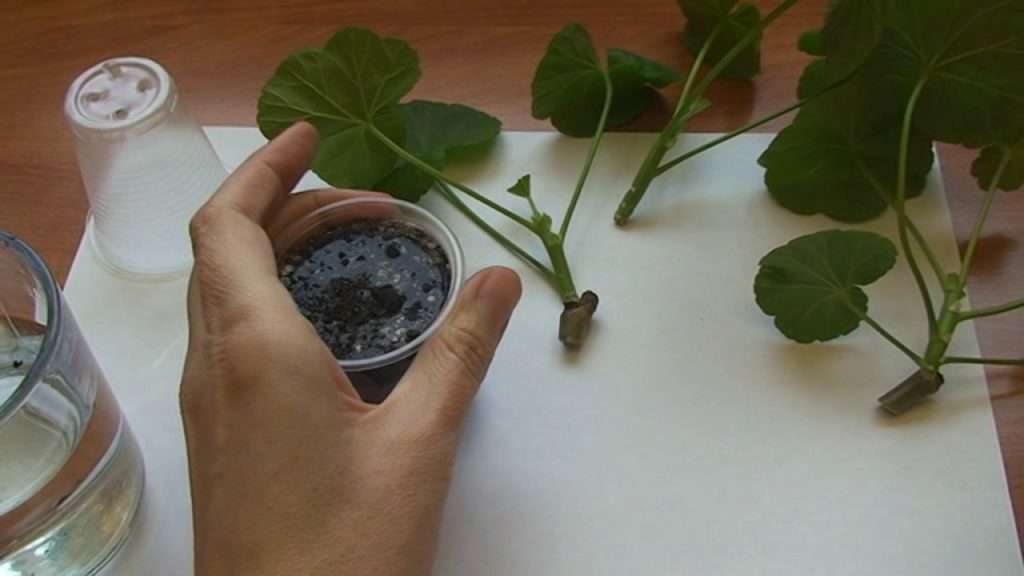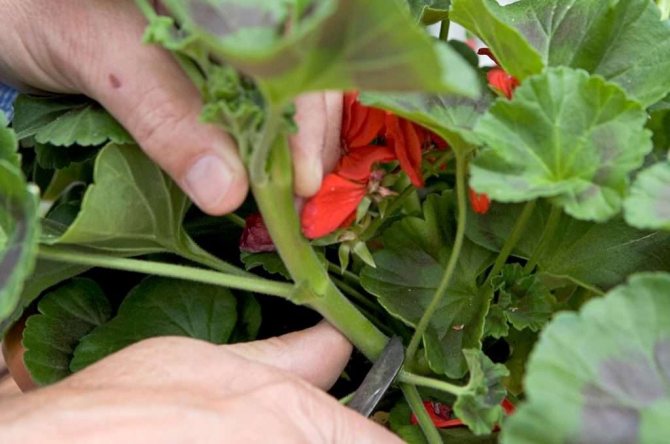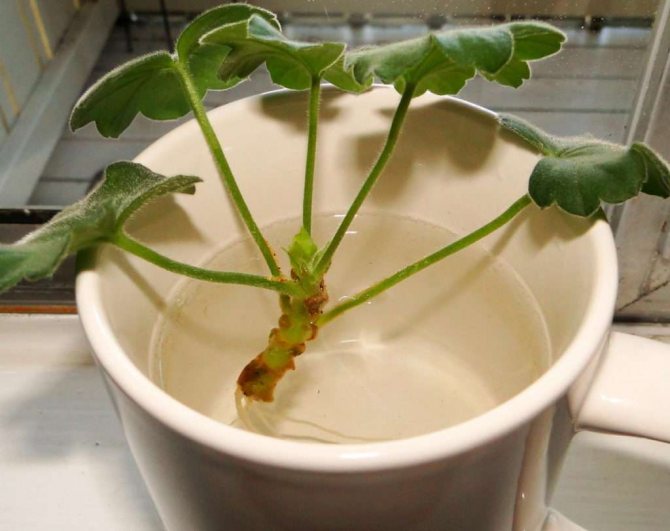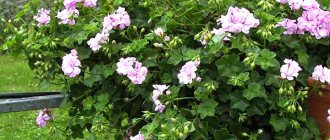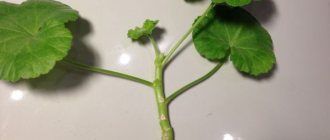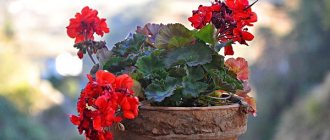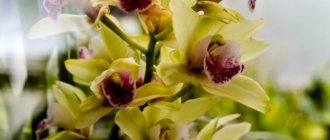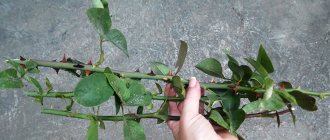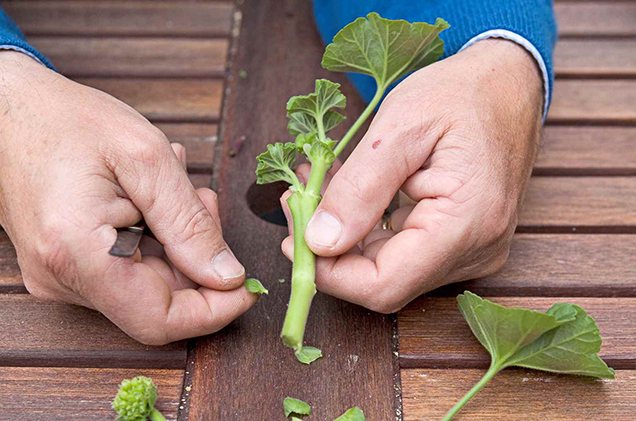
Geranium, or Pelargonium, is a genus that includes 300 plants. Among the representatives of this genus, both indoor and garden species are represented. Perennial has long been famous for its bright long flowering, unpretentious care. Pelargonium can be planted with seeds, but the signs of the variety in ornamental species may disappear. It is better to propagate geraniums by cuttings. This method is simpler and more convenient.
Features of the reproduction of geraniums at home
Gardeners are divided over when is the best time to propagate the plant. It all depends on the chosen method. Experts agree on one thing: the best period is spring or autumn.
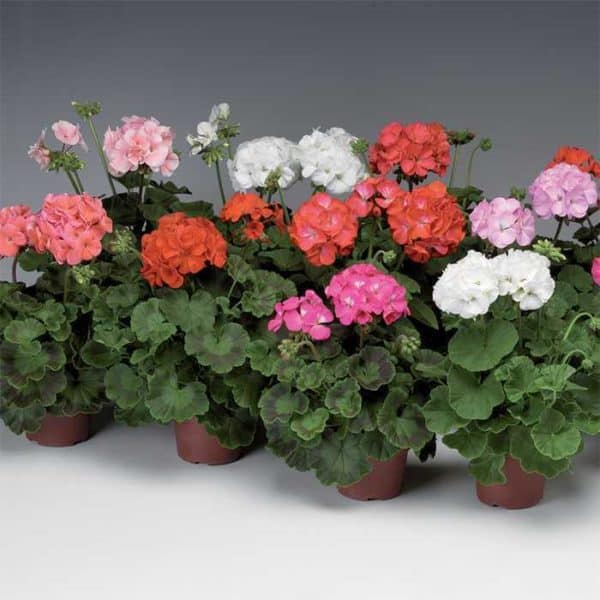

Composition from varieties of geranium
Note! For pelargonium, the most favorable time for cuttings is autumn (late August - early September). This is because pruning the plant after flowering produces good, strong cuttings.
If the purpose of breeding geraniums is rapid flowering, then it is worth starting reproduction in March. Then, already in July, it will be possible to get lush buds on a young flower. The survival rate of spring plantings is 90%. It is more correct to start pruning cuttings in September, then the flower will grow and develop intensively, flowering will come next year. The planting survival rate during this period is 80-90%.
The most unfavorable breeding period for geraniums is mid-summer, in which case the percentage of established plants is minimal. It is optimal to start sowing seeds in March, when there is already enough sunlight. If you plant seeds earlier, the gardener should provide crops with an additional source of light.
Geranium can be propagated using a leaf at any time of the year. The method is relevant in cases where it is impossible to obtain a cutting. Working with royal pelargonium or ampelous (ivy) is more difficult than with ordinary one.
Care of young plants
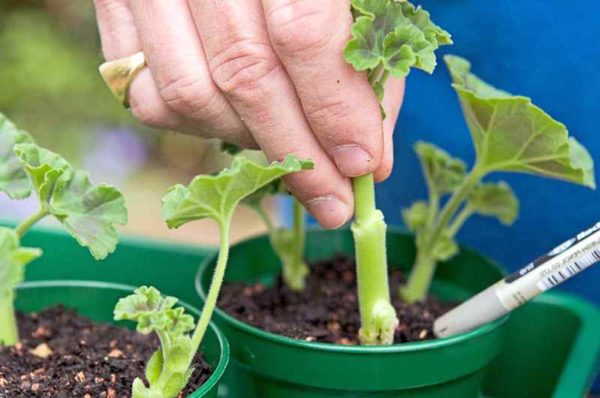

Young geraniums are looked after in the same way as adult plants. Pots with bushes are installed on southern windowsills with good lighting or light partial shade. In a particularly hot time of the day, geraniums are shaded so that the sun's rays do not burn the leaves.
In the hot season, geraniums are often watered. The amount of winter watering is reduced to 1-2 times a week. It depends on the type and condition of the air in the room. Additional moistening in the form of spraying or sprinkling with pelargonium is not needed. Regularly loosen the soil in containers and remove withered leaves and faded buds.
To activate growth and provoke geraniums to bloom, they feed it with mineral complexes with a small amount of nitrogen twice a month in spring and summer. To make the bush more lush, pinch the top of the geranium and several side shoots.
How to propagate royal geranium by cuttings at home
How to propagate ampelous geranium at home
One of the most beautiful geranium species is royal pelargonium. Breeders have bred a large number of varieties of royal and ivy pelargonium, but all of them are more demanding in care and reproduction compared to other species.To know how to propagate royal geranium by cuttings at home, you need to follow the step-by-step scheme used by experienced growers.
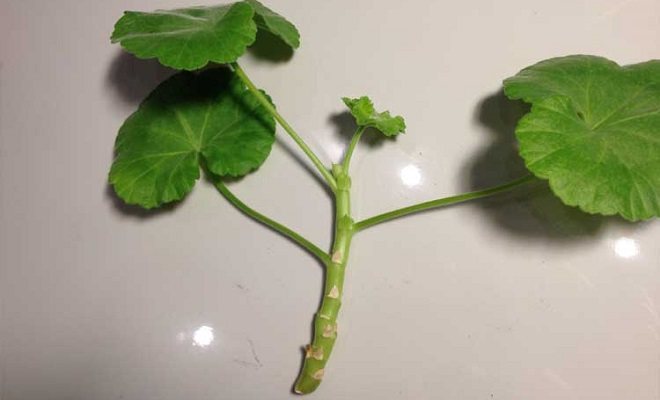

What does a geranium stalk look like?
It's important to know! The main requirement for the propagation of royal pelargonium is to avoid excessive moisture in the soil or substrate. With excessive moisture, the shoots of the plant will begin to rot and disappear.
How to cut geraniums from a mother plant
To obtain new plants of royal geranium, it is better to propagate by cuttings from late August to early September. Since pruning occurs after flowering, propagation cuttings will be strong and healthy.
In the spring, the plant wakes up from hibernation. All vital processes begin to activate, and if you choose the right time, you can enjoy the lush flowering already in June. The opposite result may also occur, and then flowering will come only after a year. How does geranium breed?
Geranium propagation should be carried out from a healthy and robust-looking mother plant. The average cutting length is 8-20 cm, depending on the size of the original flower. Shoots on which more than 5-6 leaves are located are not recommended to be taken due to the low probability that the cutting will give back roots.
Additional Information! Cuttings are separated from the mother shoot with a sharp knife below the node at a slight angle. After that, the lower leaves on the handle are removed. If the cutting has too large upper leaves, then they must be cut in half, so that all the forces of the future plant do not go to feed the leaves, but go to the formation of the root system.
Rooting methods
There are several ways to root geraniums from cuttings obtained:
- using plain water;
- landing in light soil;
- apply a specialized peat tablet.
Each method has its own characteristics, and the success of any method depends on the technology for obtaining the mother bush. By choosing a similar scheme, the chances of a positive result are increased and rooting is faster.
Getting rootlets with plain water means changing the fluid every 2-3 days. An opaque container is filled with water no more than 3-5 cm and placed on a well-lit window. After the roots appear, the cuttings are planted in temporary pots with rich soil.
Using the method of planting in light soil, the planting material is pre-dried for about 2 hours, the cut sites are treated with charcoal and planted in the ground without waiting for the roots to appear.
On a note! A rooting pot is chosen with a small diameter, the lower part is filled with drainage, the rest of the container is filled with a substrate of peat and sand in equal volumes.
The best method of vegetative propagation of royal pelargonium is considered to be rooting with a peat tablet. This method does not involve planting shoots in the ground, but is based on the use of a special medium of peat and nutrients. This substrate promotes rapid root growth of the plant. The probability of stem decay is minimized, but before putting the shoot in a peat tablet, it is kept in water for 5-15 days until the first roots appear. When the roots completely entwine the tablet, they immediately begin to plant them in a spacious pot.
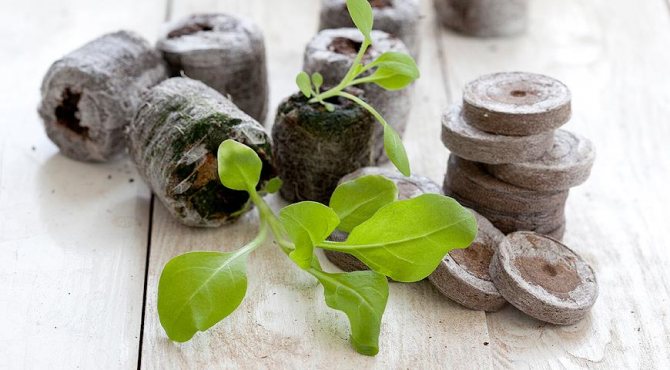

Peat tablets for rooting geranium cuttings
Planting in the ground and further care
Cuttings of royal geraniums are popular due to their fast rooting, subject to all the rules of this procedure. After the formation of the root system, the first sprouts begin to appear on the cuttings within 3-4 weeks, at which time watering is increased.
Note! It is necessary to water the plant carefully, do not be zealous with moisture.King geraniums tolerate drought better than excess moisture.
An increase in watering does not mean that the flower is ready for full-fledged care like an adult plant. It is necessary to wait another month before starting to gradually harden the flower in the sun. After a while, the plant is transferred to the care scheme as an adult.
Transplantation into permanent soil is carried out only after the formation of a strong root system. If you do a transplant earlier, there is a chance that the plants will not take root. The soil is prepared from compost (humus, sand, leaf and sod land in equal proportions).
In the cold season, the flower is at rest. Cultivation in winter takes place at a temperature of +15 ℃. If such conditions cannot be created, the plant is left dormant until March. The shoots are shortened, the roots are cleaned of soil and pruned, wrapped in newspaper or film and then hung in the basement.
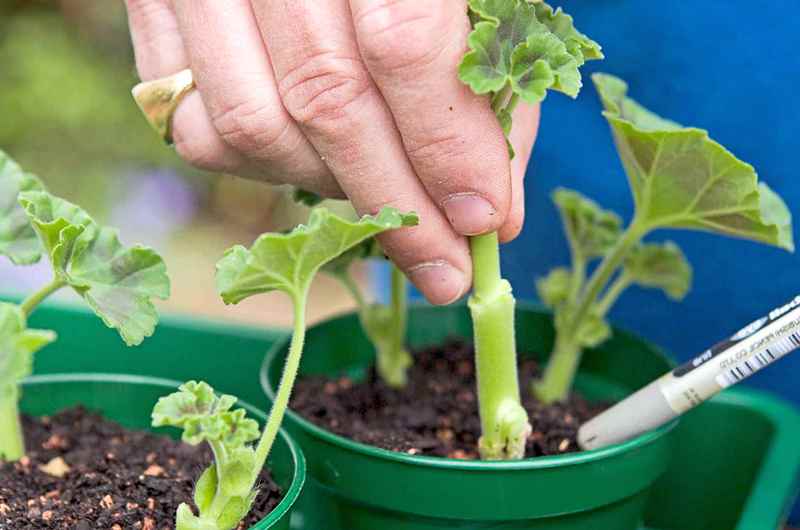

Planting cuttings in the ground
Possible difficulties
Geranium is an unpretentious plant, but some problems may arise during its reproduction. So, sometimes the rooting of the cuttings does not occur in the water. Some species do not grow roots in water. You can try placing the scion in the ground. The trim should have at least two leaf nodes or one, but with a bud and heel. The water must be periodically changed by dissolving an activated carbon tablet in it. Without proper care, the stem will rot. One bud is left above the liquid level, the rest of the plant is submerged.
Breeding methods for raspberries and ezemalina cuttings in autumn
A florist may face other difficulties:
- The stalk does not root in the soil. There are varieties with a long rooting period, for the development of which you need to wait 1-2 months. The earth needs regular watering. The shoot should not be covered, lack of air will lead to decay and growth arrest. The planting material needs to be deepened enough, only the growth point remains on top.
- Seeds do not sprout. Planting depth should not exceed 3-4 mm, otherwise re-seeding will be required. Poor seed quality also inhibits seed growth.
- Seedlings die. The sprouts require good aeration, loose and moist soil, without an excess of water. The soil can be affected by the black leg. For prevention, you need to disinfect the seeds before sowing, ventilate the seedlings and sprinkle the soil with ash. Infected plants must be removed from the general container, water the ground with a solution of concentrated potassium permanganate and sprinkle with crushed charcoal. You can also transplant young plants into healthy soil.
- Shoots stretched out. Pelargonium requires a lot of light, so it is better to sow seeds not earlier than March or use a light. Alternatively, the pot is placed on the east or west window. The flower can be turned on the other side of the glass every day.
How to propagate geraniums by shoots at home
Diluting geraniums by trimming the shoots is not difficult. To do this, leave a stump of a given height, and on the residual shoot under the bud itself, make a large number of circular cuts through one bud. Repeat the procedure to the very top.
Geranium - home care, how to water geranium
As a result, a large number of cuttings are formed from the cuts, which develop their root system directly on the mother plant. After the young shoots have grown stronger and the root system has become powerful enough, the plants can be planted, the cuttings obtained in this way will quickly take root.
Additional Information! If problems arise with the rooting of shoots, the appearance of future roots is stimulated. For this, special means are used according to the instructions in order to help the geranium to multiply with the help of cuts on the shoot of the mother plant.
Caring for cuttings after rooting
The growth of new leaves will signal the successful rooting of shoots. In this case, you can transplant geraniums into a new container along with an earthen lump. At the same time, the pot should be slightly larger than the previous one - in a too spacious container, budding will occur much later, since the plant will direct all its forces to fill the free space with roots.
After planting geraniums in a permanent pot, pinching the top of the head is recommended - this will help the plant quickly take the shape of a bush.
You need to put geranium on a windowsill with sufficient illumination and no drafts. Watering should be moderate, and if the soil is very dry, it is recommended to moisten it a little in order to exclude diseases of the root system.
Pelargonium reacts negatively to spraying the leaves - such care will have to be abandoned in the name of the health of the bush. During the active growing season, the flower is fertilized with potassium-phosphorus mineral fertilizers, which stimulate budding.
Geranium, or Pelargonium, is a genus that includes 300 plants. Among the representatives of this genus, both indoor and garden species are represented. Perennial has long been famous for its bright long flowering, unpretentious care. Pelargonium can be planted with seeds, but the signs of the variety in ornamental species may disappear. It is better to propagate geraniums by cuttings. This method is simpler and more convenient.
How to propagate a geranium leaf at home
How to propagate a Decembrist at home: examples without roots and leaves
In some cases, it happens that a healthy, strong stalk cannot be diluted. In such cases, a plant leaf is used. The leaf itself cannot take root, it can be helped. To do this, leave part of the stem together with the leaf. After cutting off the stem with the leaf, processing is carried out as for grafting. Preparing the soil follows the same principle as with conventional cuttings. Next, a transparent cup is filled with a substrate, in which a stump with a leaf must be planted. The care scheme for such seedlings is identical as for the care of cuttings.
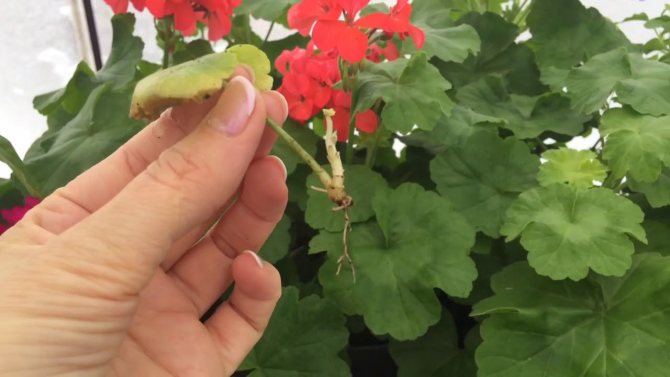

Leaf propagation
Seed propagation
Seed propagation is another way to get a lot of plants. It has a significant drawback - plants grow from seeds that differ in characteristics from the mother. The color of flowers, their shape, terry are lost. If the main task is to quickly plant the garden, then propagating by seeds is an excellent option. In this case, seeds collected from their flowers are used. To create certain color compositions, seeds are bought at a flower shop.
Note! Geranium seeds are planted mainly in cases when it comes to a large number of plants at once, for example, to decorate city parks and flower beds. Cutting is not suitable for such volumes.
Before planting, they prepare their own seeds - scarification. The shell of pelargonium seeds is very dense and tough, which is why they can lie in the soil for 3 months before germinating.
Scarification technology consists in gentle grinding of seeds between two sheets of fine-grained sandpaper. When sowing geraniums with seeds, factors are taken into account:
- the correct time for sowing seeds (you can start planting from the end of December or the beginning of January);
- the dependence of the temperature regime and the timing of germination (the substrate temperature should be maintained within 18-20 ℃ above zero);
- substrate (turf, sand and peat in a ratio of 2: 1: 1);
- correct picking and sprout care.
Do not delay with a pick, otherwise the root system will grow and intertwine. Seedling development will be delayed. After the appearance of the sixth leaf on young plants, they are pinched and shaped so that in the future geraniums grown from seeds at home will please with lush flowering.


Growing pelargonium from seeds
Transfer
Pelargoniums are grown in pots with a volume of no more than 0.75 liters. Too large capacity of the container provokes the plant to build up the root system and green mass. This reduces flowering rates. For the same reason, geraniums are not fed with nitrogen fertilizers. The selected pot at the bottom must have holes. It is filled with 15% expanded clay drainage.
Read also: How to cook frozen boletus
For the growth of geraniums, a soil mixture is suitable, consisting of:
- 2 parts of sod land;
- 1 part peat;
- 1 part sand.
The prepared soil is watered with a weak solution of potassium permanganate for disinfection and structuring, and then two-thirds of the prepared pot is filled with it. Then the rooted cutting is transferred to a pot. It is advisable to do this by transshipment, so as not to disturb the root system once again. The remaining space is filled with soil, occasionally shaking the container to avoid the formation of voids. Then the flower is watered with lukewarm, previously settled water.
What difficulties can you face
Reproduction of geraniums at home is easy to carry out, but it is still worth remembering some aspects. Sometimes pelargoniums affect diseases and pests. The main problems when growing geraniums:
- Yellowing of the lower leaves with a lack of moisture.
- Redness of the edges of the leaves when the plant freezes.
- Darkening of the shoot at the base with a lesion with a black leg. Unfortunately, such a plant cannot be reanimated.
- Exposure of the stem with a lack of light.
- The appearance on the leaves of gray mold with excessive moisture.
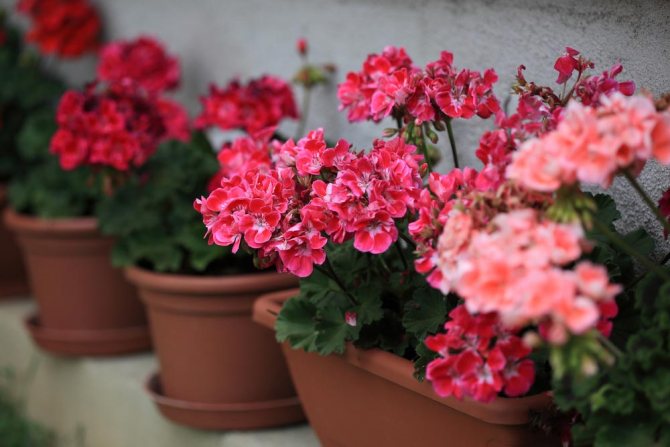

Home-grown geranium
Breeding geraniums at home is not difficult, the main thing is to choose the right time, choose a more convenient breeding method and the right substrate. In this case, you can grow a real beauty on the windowsill, which will be a true decoration of the house.
Tips & Tricks


In order for grafting to be successful, florists with extensive experience advise:
- a few days before cutting the cuttings, stop watering the mother bush;
- to protect against fungus, cover the planted cuttings with plastic bags or glass jars for 2 days;
- for planting cuttings, use small pots or place several pieces in flowerpots;
- do not use clay pots with a porous structure for growing geraniums, as they provoke moisture evaporation;
- in summer, transplant geraniums to a garden on a flower bed or simply take out the pots to the open air.

